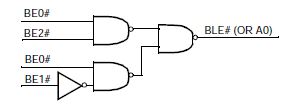monahanz
Junior Member level 1

- Joined
- Nov 11, 2013
- Messages
- 19
- Helped
- 0
- Reputation
- 0
- Reaction score
- 0
- Trophy points
- 1,281
- Location
- San Ramon CA
- Activity points
- 1,490
Could somebody help me on this what I'm sure is a trivial PALASM question.
Starting with this schematic:-

There are 3 NAND gates and one Inverter (input BE1*)
I want to burn a GAL using the four inputs to get the A0 output with PALASM
Since PALSAM does not accept brackets in its EQUATIONS how do I combine the two inputs to the right hand side NAND.
I know I could make two intermediate pins and do this:-
X = \BE0 * \BE2
Y = \BE0 * BE1
/A0 = X * Y
But this uses up two (useless) pins. I considered
A0 = \BE0 * \BE2
+ \BE0 * BE1
But that does not give the correct state
Starting with this schematic:-

There are 3 NAND gates and one Inverter (input BE1*)
I want to burn a GAL using the four inputs to get the A0 output with PALASM
Since PALSAM does not accept brackets in its EQUATIONS how do I combine the two inputs to the right hand side NAND.
I know I could make two intermediate pins and do this:-
X = \BE0 * \BE2
Y = \BE0 * BE1
/A0 = X * Y
But this uses up two (useless) pins. I considered
A0 = \BE0 * \BE2
+ \BE0 * BE1
But that does not give the correct state
Last edited by a moderator:
